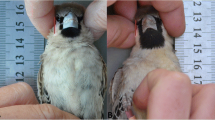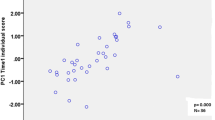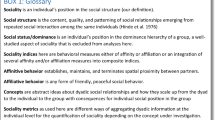Abstract
Agonistic behavior was studied longitudinally for 16 months in an intact family groups of captive emperor tamarins (Saguinus imperator subgrisescens) using methods from quantitative ethology and social network analysis. A motivational analysis of the components of agonistic display revealed the relative strength of each component along a continuum from strongly dominant to strongly subordinate. Tabulations of exchanges of strongly dominant and strongly subordinate components in interactions among the tamarins revealed an agonistic network (“dominance hierarchy”) that approached, but did not quite reach, the ideal state of a transitive order (“linear dominance hierarchy”). The frequency with which individual tamarins long called and scent marked was not closely correlated with their position (“dominance rank”) in the agonistic network. Instead, individuals undergoing change in status long called and scent marked frequently, irrespective of their rank.
Similar content being viewed by others
References
Abbott, D. (1984). Behavioral and physiological suppression of fertility in subordinate marmoset monkeys.Am. J. Primatol. 6: 169–186.
Abbott, D. (1987). Behaviourally mediated suppression of reproduction in female primates.J. Zool. Lond. 213: 455–470.
Abbott, D. H., and Hearn, J. P. (1978). Physical, hormonal and behavioural aspects of sexual development in the marmoset monkey,Callithrix jacchus.J. Reprodu. Fertil. 55: 155–166.
Abbott, D., Hodges, J. K., and George, L. M. (1988). Social status controls LH secretion and ovulation in female marmoset monkeys (Callithrix jacchus).J. Endocrin. 117: 329–339.
Abbott, D. H., Barrett, J., Faulkes, C. G., and George, L. M. (1989). Social contraception in naked mole-rats and marmoset monkeys.J. Zool. Lond. 219: 703–710.
Baker, F., and Hubert, L. J. (1981). The analysis of social interaction data.Soc. Meth. Res. 9: 339–361.
Cleveland, J., and Snowdon, C. T. (1982). The complex vocal repertoire of the adult cotton-top tamarin (Saguinus oedipus oedipus).Z. Tierpsychol. 58: 231–270.
Coates, A., and Poole, T. B. (1983). The behavior of the callitrichid monkey,Saguinus labiatus labiatus, in the laboratory.Int. J. Primatol. 4: 339–371.
Darwin, C. (1872).The Expression of the Emotions in Man and the Animals, John Murray, London.
Dow, M., and de Waal, F. B. M. (1989). Assignment methods for the analysis of network subgroup interactions.Social Networks 11: 237–255.
Epple, G. (1970). Quantitative studies on scent marking in the marmoset (Callithrix jacchus).Folia Primat. 13: 48–62.
Epple, G. (1975) The behavior of marmoset monkeys (Callitrichidae).Primate Behavior 4. Developments in Field and Laboratory Research, Academic Press, New York.
Epple, G., and Katz, Y. (1980). Social influences on first reproductive success and related behaviors in the saddle-back tamarin (Saguinus fuscicollis, Callitrichidae).Int. J. Primatol. 1: 171–183.
Epple, G., and Katz, Y. (1984). Social influences on estrogen excretion and ovarian cyclicity in saddleback tamarins (Saguinus fuscicollis).Am. J. Primatol. 6: 215–227.
Fagen, R. M., and Young, D. Y. (1978). Temporal patterns of behaviors: Durations, intervals, latencies, and sequences, In Colgan, P. (ed.),Quantitative Ethology, Wiley-Interscience, New York.
French, J. A., Abbott, D. H., and Snowdon, C. T. (1984). The effect of social environment on estrogen excretion, scent marking, and sociosexual behavior in tamarins (Saguinus oedipus).Am. J. Primatol. 6: 155–167.
French, J. A., and Inglett, B. J. (1989). Female-female aggression and male indifference in response to unfamiliar intruders in lion tamarins.Anim. Behav. 37: 487–497.
Golani, I. (1973). Non-metric analysis of behavior interaction sequences in captive jackals (Canis aureur L.).Behaviour 44: 89–112.
Heisterman, M., Kleis, E., Pröve, E., and Wolters, H-J. (1989). Fertility status, dominance, and scent marking behavior of family-housed female cotton-top tamarins (Saguinus oedipus) in absence of their mothers.Am. J. Primatol. 18: 177–189.
Hubert, L. (1987).Assignment Methods in Combinatorial Data Analysis, Dekker Press, New York.
Inglett, B. J., French, J. A., Simmons, L. G., and Vires, K. W. (1989). Dynamics of intrafamily aggression and social reintegration in lion tamarins.Zoo Biol. 8: 67–78.
Iverson, G. J., and Sade, D. S. (1990). Statistical issues in the analysis of dominance hierarchies in animal societies.J. Quant. Anthropol. 2: 61–83.
Kleiman, D. G. (1984). The behavior and conservation of the golden lion tamarin,Leontopithecus rosalia. In Thiago de Mello, M. (ed.),A Primatologica no Brasil, Universidadae de Brasilia, Brasilia.
Knox, K. L. (1989).Observations on Dominance Relations Among Saguinus imperator, the Emperor Tamarin (Family: Callitrichidae). Doctoral dissertation, Department of Anthropology, Northwestern University, Evanston, Ill.
Lorenz, K. (1966).On Aggression, Harcourt, Brace & World, New York.
Mantel, N. (1967). The detection of disease clustering and a generalized regression approach.Cancer Res. 27: 209–220.
McConnell, P. B., and Snowdon, C. T. (1986). Vocal interactions between unfamiliar groups of captive cotton-top tamarins.Behaviour 97: 273–296.
Rowell, T. E. (1966). Hierarchy in the organization of a captive baboon group.Anim. Behav. 14: 430–443.
Sade, D. S. (1967). Determinants of dominance in a group of free-ranging rhesus monkeys. In Altmann, S. A. (ed.),Social Communication Among Primates, University of Chicago Press, Chicago, pp. 99–114.
Sade, D. S., (1973). An ethogram for rhesus monkeys. I. Antithetical contrasts in posture and movement.Am. J. Phys. Anthropol. 38(2): 537–541.
Savage, A., Ziegler, T. E., and Snowdon, C. T. (1988). Sociosexual development, pair bond formation, and mechanisms of fertility suppression in female cotton-top tamarins (Saguinus oedipus oedipus).Am. J. Primatol. 14: 345–359.
Scanlon, C. E., Chalmers, R. A., and Monteiro da Cruz, M. A. O. (1988). Changes in the size, composition and reproductive condition of wild marmoset groups (Callithrix jacchus jacchus) in North East Brazil.Primates 29(3): 295–305.
Snowdon, C. T. (1982). Linguistic and psycholinguistic approaches to primate communication. In Snowdon, C. T., Brown, C. H., and Petersen, M. R. (eds.),Primate Communication, Cambridge University Press, Cambridge, pp. 212–238.
Stevenson, M. F., and Poole, T. B. (1976). An ethogram of the common marmoset (Callithrix jacchus jacchus): General behavioural repertoire.Anim. Behav. 24: 428–451.
Sussman, R. W., and Garber, P. (1987). A new interpretation of the social organization and mating system of the Callitrichidae.Int. J. Primatol. 8: 73–92.
Sutcliffe, A. G., and Poole, T. B. (1984). Intragroup agonistic behavior in captive groups of the common marmosetCallithrix jacchus jacchus.Int. J. Primatol. 5: 473–489.
Terborgh, J. (1983).Five New World Primates: A Study in Comparative Ecology, Princeton University Press, Princeton, N.J.
Wilkinson, L. (1987).SYSTAT. The System for Statistics, SYSTAT, Inc., Evanston, Ill.
Widowski, T. M., Ziegler, T. E., Elowson, A. M., and Snowdon, C. T. (1990). The role of males in the stimulation of reproductive function in female cotton-top tamarins,Saguinus o. oedipus.Anim. Behav. 40: 731–741.
Author information
Authors and Affiliations
Rights and permissions
About this article
Cite this article
Knox, K.L., Sade, D.S. Social behavior of the emperor tamarin in captivity: Components of agonistic display and the agonistic network. International Journal of Primatology 12, 439–480 (1991). https://doi.org/10.1007/BF02547634
Received:
Accepted:
Issue Date:
DOI: https://doi.org/10.1007/BF02547634




